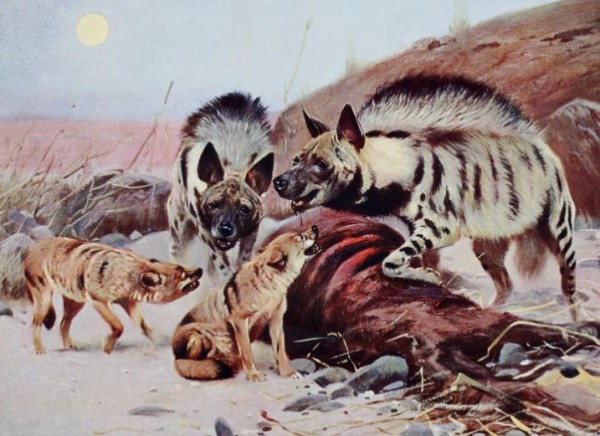By Ana Verayo, | March 20, 2016

Striped hyenas and grey wolves were seen hunting together in the Middle East.
When environmental conditions start to become harsh, carnivores in the wild might want to cooperate with fellow predators such as the hyenas and wolves in the deserts of Israel, where researchers documented this never before seen animal behavior.
In this new study, an international team of scientists from the United States and Israel reveal sightings of striped hyenas now roaming among packs of grey wolves in the Negev Desert, in southern Israel. Both animals animals are known to be vicious and neither hyenas nor wolves are known to have good relationships with other predators.
Like Us on Facebook
Hyenas usually steal kills and prey from other animals, even lions and leopards to cheetahs. Wolves on the other hand, consider coyotes and dogs as prey.
According to the co-authors of the study, researcher Vladimir Dinets and zoologist Beniamin Eligulashvili from the University of Tennessee, these two species of animals that have decided to travel together are a prime example of animals adapting to their environment by adjusting their own rules and instincts for surviving an extreme landscape.
According to Dinets, animal behavior is more often than not more flexible than what is described in textbooks. If the situation calls for it, animals have the ability to abandon their usual strategies in hunting and in the process, learn something completely new to them and unexpected which can be a useful skill for people too.
Researchers suspect that these predatory creatures are apparently willing to settle with this kind of set-up with each other since they both get something beneficial with this arrangement. Wolves are very skillful at taking down large prey by their own while hyenas have powerful sniffing skills that can detect prey from miles away and even track down dead animals that are still worth eating.
Scientists also say that hyenas are also very adept in scrounging for food from human garbage, digging up edible ones from buried trash and also opening cans and boxes as well.
The team first took note of their tracks on the ground where researchers theorize that they could possibly be wandering together, and after four years, some eyewitnesses finally saw the two species moving together as a pack through the canyons of the Negev desert.
Scientists cannot confirm yet if this phenomenon of animals roaming the desert is an aberration or something that is normally happening now. This new study is published in the journal Zoology.
-
Use of Coronavirus Pandemic Drones Raises Privacy Concerns: Drones Spread Fear, Local Officials Say

-
Coronavirus Hampers The Delivery Of Lockheed Martin F-35 Stealth Fighters For 2020

-
Instagram Speeds Up Plans to Add Account Memorialization Feature Due to COVID-19 Deaths

-
NASA: Perseverance Plans to Bring 'Mars Rock' to Earth in 2031

-
600 Dead And 3,000 In The Hospital as Iranians Believed Drinking High-Concentrations of Alcohol Can Cure The Coronavirus

-
600 Dead And 3,000 In The Hospital as Iranians Believed Drinking High-Concentrations of Alcohol Can Cure The Coronavirus

-
COVID-19: Doctors, Nurses Use Virtual Reality to Learn New Skills in Treating Coronavirus Patients







